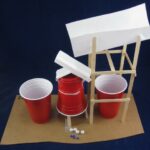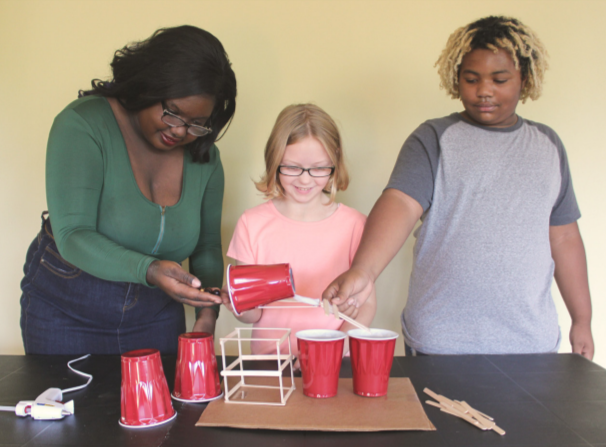Overview
STEM careers
Time
Materials
Per Team:
- For the base: 1 piece of corrugated cardboard, up to 2 ft by 2 ft
- 16 oz paper or plastic cups
- Popsicle sticks, regular size
- 8.5″x11″ sheets of paper
- Clear adhesive tape
- Bottle of glue
- Two sizes of plastic or wooden beads, approximately 1/4″ and 1/2″
- Scissors
- Stopwatch
- Pencils for drawing designs
Instructions
DEFINE THE PROBLEM
- Show students images of sorting machines such as a coin sorter, a pan for panning gold, and a winnower for separating wheat from chaff. Ask what these machines have in common. Discuss the role of gravity in each.
- Tell students they will design a machine that separates “rocks” from “gems” into separate cups, represented by two different sizes of plastic or wooden beads. Their machine will be powered by gravity. Hint: beads may be sorted by size or weight.
- Divide students into teams of 3–4 and distribute materials. Each team receives one cardboard base.
- Instruct teams to experiment with the materials and sketch their design ideas. As needed, note that paper can be folded to make chutes. Encourage students to roll the beads down various inclines or to test gaps between popsicle sticks if they are separating beads by size.
- Tell students to build their prototypes. Assure them that after their prototypes have been tested, they can come up with design improvements.
- To test the machines, use the same number of beads for each team and a stopwatch to see which machines are the most efficient. Invite teams to make improvements.
- As time allows, have each team demonstrate their machine for the full group, and lead a discussion about the strengths and weaknesses of the various machines. What could be changed to improve them?

BRAINSTORM SOLUTIONS
TEST

Guiding questions
-
How do you think you could redesign your machine for better results?
-
What other materials might make good sorting machines? Why?
-
If you were sorting marbles or ball bearings, which materials would you want to change? Why?
-
What do you have to sort in your everyday life that would be easier if it were done with a simple machine?
Used with permission and adapted from the Sorting Solutions activity developed by Science Buddies. This project is based on the “Journey of Gold” friendly Engineers Week competition designed by employees of Fluor Corporation located in Al Khobar, Saudi Arabia. For more activities like these, visit: sciencebuddies.org/fluor-challenge


0 Comments